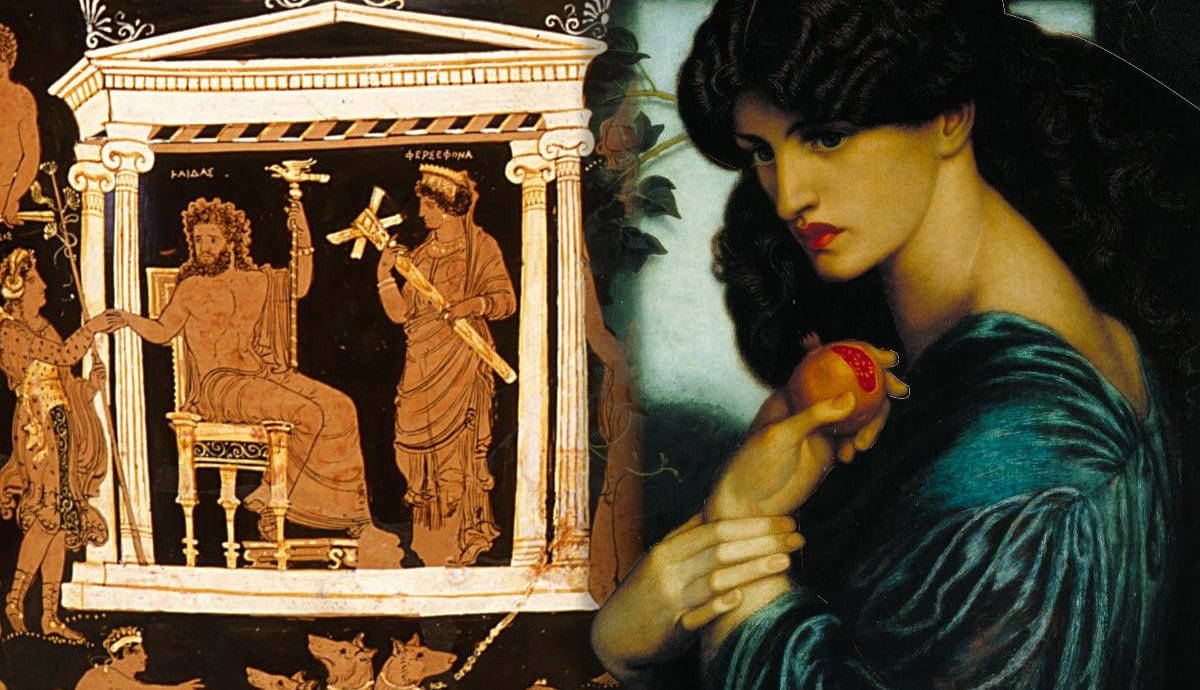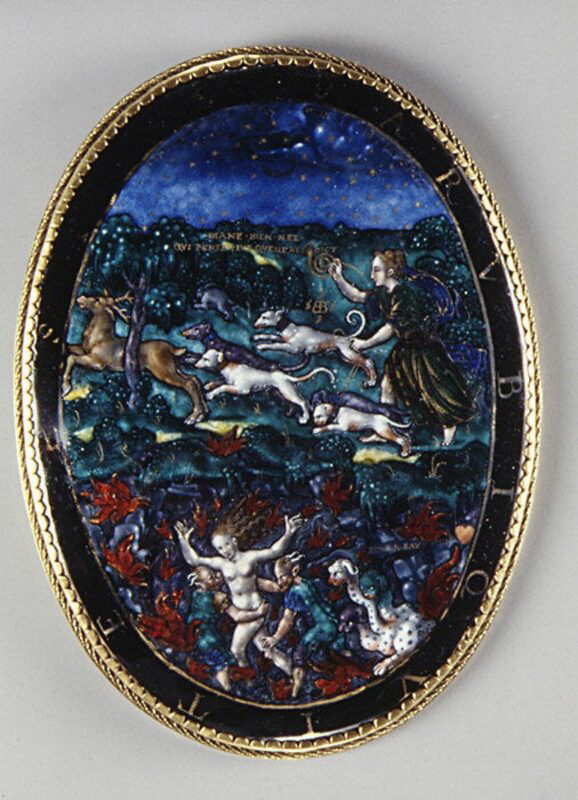
The goddess Persephone served in many roles across Greek mythology. Her relationship with Hades remains one of the most infamous stories in the Greek mythological canon, specifically, the various versions of how Hades and Persephone came to be a couple. Additionally, as Queen of the Underworld, she played an essential part in multiple other great stories from Hercules and Orpheus to Sisyphus and beyond.
The Goddess Persephone’s Many Names

Persephone is most commonly known today by her Greek name meaning “Destroy-Slay,” but she was also known by many other monikers and titles throughout Greek and Roman mythologies. Initially, she was known as Kore, “The Maiden,” a reference to her determined virgin status and her role as Goddess of Spring. In Roman mythology, she is known as Proserpina or Proserpine and Mistress of the Erinyes, otherwise known as the Three Furies: Allecto, Megaera, and Tisiphone.
As Demeter’s daughter, and because of her close relationship with her mother, Persephone and her mother had the collective titles of “The Two Demeters” and “The Two Goddesses” to represent both the intimate nature of their relationship and their shared agricultural duties.
In her role as Queen of the Underworld, she was known by many titles, including “The Pure One,” “The Venerable One,” and “The Great Goddess.” It is likely that she was given these names because she was feared by humans who knew her to be a ruler of the Underworld. The greater (and nicer) a name a god or goddess received, the more likely they were to be feared. The names were thought to appease the feared gods and goddesses in some way.
Persephone’s Role in Greek Mythology

Get the latest articles delivered to your inbox
Sign up to our Free Weekly Newsletter
The goddess Persephone is known for serving as Goddess of Spring, but she also operated in a variety of other important roles in Greek mythology. Like her mother, Demeter, Persephone was an agriculturally-based goddess who presided over grains and vegetation, leading her to be known as the Goddess of Vegetation. However, aside from serving in her own individual role as one of the Olympian gods, she also ruled over the Underworld with Hades.
In the Underworld, Persephone was something of a protectress. Hades had many dealings with various heroes like Hercules, Odysseus, and Orpheus that traipsed throughout his domain, and usually, he was not very understanding once he discovered them. In most cases, these heroes ended up owning their lives and eventual freedom to Persephone, who would intervene and rescue heroes from what would often be grisly fates.
Persephone’s Family

Persephone was born to the Greek gods Zeus and Demeter. Demeter was most commonly recognized as the Goddess of the Harvest, and in that role, she watched over all grains and fertility on Earth. She also served as the goddess of agriculture, fertility, the cycle of life, sacred law, and death. She gave birth to her daughter, Persephone, and it was her daughter’s story for which she was most well-known. Unlike many other Greek gods and goddesses, Demeter was not mentioned very often by Homer, but her legend in relation to Persephone was likely quite ancient.
Zeus, unlike his sister and fourth wife, Demeter, is much more widely known. His exploits and various relationships have marked most of Greek mythology in one way or another. Zeus was the chief deity of the Olympian pantheon and served as God of the Sky. He was seen as a ruler, protector, and father to both gods and human beings and was often represented by lightning bolts and eagles.
In addition to her parents, Persephone had one full sibling, a minor deity named Iacchus, and a myriad of half-siblings from both her mother and father.
The Abduction of Persephone and the Origin of Seasons

Popular in Greek Mythology was the story of Hades and Persephone, which goes as follows. Hades, the god of the Underworld, saw Persephone one day while she was picking narcissus flowers in one of her mother’s fields. He fell in love with her after Aphrodite, the goddess of love, struck him with a love-arrow and swept her away in his chariot to live with him in the Underworld. When Demeter discovered that Persephone was missing, she searched all over the Earth for her until Hermes her what Hades had done. Demeter continued searching for her daughter but did not find her. She then withdrew from the world to live in a temple she had built in Persephone’s honor. Then, she caused a great drought to fall on the land to force the gods to confront Hades so that he would release her daughter.
Eventually, Zeus sent Hermes to convince Hades to let Persephone go. Hades agreed but offered Persephone pomegranate seeds before allowing her to leave. Unsuspicious, Persephone ate the seeds. Because she had consumed food from the Underworld, she was no longer able to be released. However, a compromise was reached in that she would be allowed to go free for part of the year as long as she returned to Hades at the end of summer. In other accounts, Hades forced the pomegranate seeds into Persephone’s mouth, but the end result was the same.
Through this tale, ancient Greeks explained the existence of the seasons because of the dual residences of Persephone. In the spring, she would return, bringing life with her and making her mother happy so that the lands prospered. Then, as she left in the fall, everything would turn grey and lifeless again until her return.
Hades and Persephone VS Zeus and Hera

In many ways, the relationship between Hades and Persephone mirrors the relationship Zeus had with Hera. Each couple was powerful in its own right and influenced Greek mythology in different ways as well. Zeus and Hades were juxtaposed as lords of the “Overworld,” otherwise known as heaven or Mount Olympus, while Hades ruled the Underworld. Each god tricked his wife into marriage one way or another, Hades with the pomegranate and Zeus by transforming himself into a little bird to gain Hera’s affections after she evaded their arranged marriage for three years. But despite their bad methods of seduction, each god loved his wife in his own way. The difference here was how they handled that love. Hera, as the goddess of marriage, wanted a husband who would honor his vows, but Zeus was nothing if not the playboy go constantly seducing anyone that crossed his fancy. Meanwhile, Hades was loyal to Persephone and never loved another. Additionally, throughout the mythologies, Zeus and Hera were constantly fighting with each other while Hades and Persephone were always noted to live happily together.
While Hera was famous for acting against her husband’s various loves by causing their deaths or punishing them in various inventive ways, Persephone only acted in contradiction to Hades, to save the lives of people who had entered the Underworld; additionally, she was able to wield her power not only to save others but to support her husband in the process. Not many other gods or goddesses were capable of such feats.
Persephone’s Children

Though a maiden goddess, zealously defended by her mother for a long time, Persephone did eventually have two children, a daughter named Melinoe and a son called Zagreus.
Melione, also called Melaina, was the goddess of ghosts and spirits. She was said to bring nightmares to whomever she visits. Most ancient sources stated that she was conceived by Persephone and Hades. However, some stories claimed that she was created after Zeus, disguised as Hades, visited Persephone. Melione, meaning “Dark-Minded,” was said to have black limbs on one side of her body and white on the other- a physical representation of her juxtaposed natures of heaven and Hades.
Zagreus, or “Great Hunter,” was the god of Orphic Mysteries. His birth was the result of a tryst between the goddess Persephone and Zeus when the god disguised himself as a serpent and seduced the Queen of the Underworld. Once he was born, Zeus placed Zagreus on the throne of heaven and gave the child his lightning bolts, unknowing that the Titanes would trick and dismember the boy once Hera poisoned their minds against him. Zeus saved the child’s heart and made it into a potion that Semele drank, thereby conceiving Dionysos.
Symbolism Associated With the Goddess Persephone

Because she was the Goddess of Spring, Persephone was often associated with many spring-themed symbols. Wreaths of flowers, reeds, lilies, and precious gems were all associated with her in various forms. Any form of vegetation, animal, or even scent representing new life was related to Persephone in some way or another because it was only upon her return to Earth that life could go on each year.
Two of her most prominent symbols were pomegranates and the narcissus flower because of their strong relation to the origin story of Hades and Persephone’s relationship. However, asphodel, or asphodelus, also played a key role in Persephone’s symbolism. Asphodelus is a type of flower that grows across Europe and the Middle East, though it can be found in other places. It was associated with Persephone because, in Greek mythology, it was the flower of the dead and the Underworld. In many depictions, Persephone is shown to wear a garland of asphodels as a sign of life in death.
In conclusion, goddess Persephone was a figure unparalleled in Greek mythology. Her power extended to places that few other gods were ever able to reach, and Hades and Persephone’s story lives on as one of the most memorable mythological tales.







